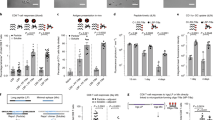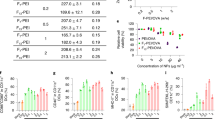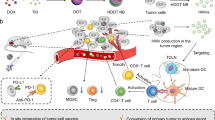Abstract
Existing strategies to enhance peptide immunogenicity for cancer vaccination generally require direct peptide alteration, which, beyond practical issues, may impact peptide presentation and result in vaccine variability. Here, we report a simple adsorption approach using polyethyleneimine (PEI) in a mesoporous silica microrod (MSR) vaccine to enhance antigen immunogenicity. The MSR–PEI vaccine significantly enhanced host dendritic cell activation and T-cell response over the existing MSR vaccine and bolus vaccine formulations. Impressively, a single injection of the MSR–PEI vaccine using an E7 peptide completely eradicated large, established TC-1 tumours in about 80% of mice and generated immunological memory. When immunized with a pool of B16F10 or CT26 neoantigens, the MSR–PEI vaccine eradicated established lung metastases, controlled tumour growth and synergized with anti-CTLA4 therapy. Our findings from three independent tumour models suggest that the MSR-PEI vaccine approach may serve as a facile and powerful multi-antigen platform to enable robust personalized cancer vaccination.
This is a preview of subscription content, access via your institution
Access options
Access Nature and 54 other Nature Portfolio journals
Get Nature+, our best-value online-access subscription
$29.99 / 30 days
cancel any time
Subscribe to this journal
Receive 12 print issues and online access
$259.00 per year
only $21.58 per issue
Buy this article
- Purchase on Springer Link
- Instant access to full article PDF
Prices may be subject to local taxes which are calculated during checkout





Similar content being viewed by others
References
Gubin, M. M., Artyomov, M. N., Mardis, E. R. & Schreiber, R. D. Tumor neoantigens: building a framework for personalized cancer immunotherapy. J. Clin. Invest. 125, 3413–3421 (2015).
Schumacher, T. N. & Schreiber, R. D. Neoantigens in cancer immunotherapy. Science 348, 69–74 (2015).
Hacohen, N., Fritsch, E. F., Carter, T. A., Lander, E. S. & Wu, C. J. Getting personal with neoantigen-based therapeutic cancer vaccines. Cancer Immunol. Res. 1, 11–15 (2013).
Linnemann, C. et al. High-throughput epitope discovery reveals frequent recognition of neo-antigens by CD4+ T cells in human melanoma. Nat. Med. 21, 81–85 (2015).
Kreiter, S. et al. Mutant MHC class II epitopes drive therapeutic immune responses to cancer. Nature 520, 692–696 (2015).
Ott, P. A. et al. An immunogenic personal neoantigen vaccine for patients with melanoma. Nature 547, 217–221 (2017).
van der Burg, S. H., Arens, R., Ossendorp, F., van Hall, T. & Melief, C. J. Vaccines for established cancer: overcoming the challenges posed by immune evasion. Nat. Rev. Cancer 16, 219–233 (2016).
Moon, J. J. et al. Interbilayer-crosslinked multilamellar vesicles as synthetic vaccines for potent humoral and cellular immune responses. Nat. Mater. 10, 243–251 (2011).
Liu, H. et al. Structure-based programming of lymph-node targeting in molecular vaccines. Nature 507, 519–522 (2014).
Cho, N. H. et al. A multifunctional core–shell nanoparticle for dendritic cell-based cancer immunotherapy. Nat. Nanotech. 6, 675–682 (2011).
Cho, H. J. et al. Immunostimulatory DNA-based vaccines induce cytotoxic lymphocyte activity by a T-helper cell-independent mechanism. Nat. Biotechnol. 18, 509–514 (2000).
Bobisse, S., Foukas, P. G., Coukos, G. & Harari, A. Neoantigen-based cancer immunotherapy. Ann. Transl. Med. 4, 262–270 (2016).
Kim, J. et al. Injectable, spontaneously assembling, inorganic scaffolds modulate immune cells in vivo and increase vaccine efficacy. Nat. Biotechnol. 33, 64–72 (2015).
Song, W. J., Du, J. Z., Sun, T. M., Zhang, P. Z. & Wang, J. Gold nanoparticles capped with polyethyleneimine for enhanced siRNA delivery. Small 6, 239–246 (2010).
Sakai, S., Yamada, Y., Yamaguchi, T., Ciach, T. & Kawakami, K. Surface immobilization of poly(ethyleneimine) and plasmid DNA on electrospun poly(L-lactic acid) fibrous mats using a layer-by-layer approach for gene delivery. J. Biomed. Mater. Res. A 88, 281–287 (2009).
Oh, Y.-K. et al. Enhanced adjuvanticity of interleukin-2 plasmid DNA administered in polyethylenimine complexes. Vaccine 21, 2837–2843 (2003).
Mulens-Arias, V., Rojas, J. M., Pérez-Yagüe, S., Morales, M. P. & Barber, D. F. Polyethylenimine-coated SPIONs trigger macrophage activation through TLR-4 signaling and ROS production and modulate podosome dynamics. Biomaterials 52, 494–506 (2015).
Wegmann, F. et al. Polyethyleneimine is a potent mucosal adjuvant for viral glycoprotein antigens. Nat. Biotechnol. 30, 883–888 (2012).
Sheppard, N. C. et al. Polyethyleneimine is a potent systemic adjuvant for glycoprotein antigens. Int. Immunol. 26, 531–538 (2014).
He, W. et al. Re-polarizing myeloid-derived suppressor cells (MDSCs) with cationic polymers for cancer immunotherapy. Sci. Rep. 6 (2016).
Hornung, V. et al. Silica crystals and aluminum salts activate the NALP3 inflammasome through phagosomal destabilization. Nat. Immunol. 9, 847–856 (2008).
Eisenbarth, S. C., Colegio, O. R., O’Connor, W., Sutterwala, F. S. & Flavell, R. A. Crucial role for the Nalp3 inflammasome in the immunostimulatory properties of aluminium adjuvants. Nature 453, 1122–1126 (2008).
Vollmer, J. & Krieg, A. M. Immunotherapeutic applications of CpG oligodeoxynucleotide TLR9 agonists. Adv. Drug Deliv. Rev. 61, 195–204 (2009).
Bartkowiak, T. et al. Unique potential of 4-1BB agonist antibody to promote durable regression of HPV+tumors when combined with an E6/E7 peptide vaccine. Proc. Natl Acad. Sci. USA 112, E5290–E5299 (2015).
Chaturvedi, A. K. Beyond cervical cancer: burden of other HPV-related cancers among men and women. J. Adolesc. Health 46, S20–S26 (2010).
Welters, M. J. et al. Vaccination during myeloid cell depletion by cancer chemotherapy fosters robust T cell responses. Sci. Transl. Med. 8, 334ra352 (2016).
Zwaveling, S. et al. Established human papillomavirus type 16-expressing tumors are effectively eradicated following vaccination with long peptides. J. Immunol. 169, 350–358 (2002).
van der Sluis, T. C. et al. Therapeutic peptide vaccine-induced CD8 T cells strongly modulate intratumoral macrophages required for tumor regression. Cancer Immunol. Res. 3, 1042–1051 (2015).
Kranz, L. M. et al. Systemic RNA delivery to dendritic cells exploits antiviral defence for cancer immunotherapy. Nature (2016).
Kvistborg, P. et al. Anti-CTLA-4 therapy broadens the melanoma-reactive CD8+ T cell response. Sci. Transl. Med. 6, 254ra128 (2014).
Li, W. A. et al. The effect of surface modification of mesoporous silica micro-rod scaffold on immune cell activation and infiltration. Biomaterials 83, 249–256 (2016).
Kim, J. et al. Effect of pore structure of macroporous poly (lactide-co-glycolide) scaffolds on the in vivo enrichment of dendritic cells. ACS Appl. Mater. Interf. 6, 8505–8512 (2014).
Moynihan, K. D. et al. Eradication of large established tumors in mice by combination immunotherapy that engages innate and adaptive immune responses. Nat. Med. 22, 1402–1410 (2016).
Höpken, U. E. et al. The ratio between dendritic cells and T cells determines the outcome of their encounter: proliferation versus deletion. Eur. J. Immunol. 35, 2851–2863 (2005).
Zhou, P. et al. In vivo discovery of immunotherapy targets in the tumor microenvironment. Nature 506, 52 (2014).
Acknowledgements
The authors would like to thank C. J. Wu (Dana Farber Cancer Institute) for providing the human neoantigen peptides. We are also grateful to G. Dranoff, C. S. Verbeke, G. J. Xu and A. S. Cheung for their helpful discussions and feedback on the manuscript. This work was supported by the National Institutes of Health (NIH) R01EB015498 and R01EB023287, the Melanoma Research Alliance Foundation, the National Science Foundation (NSF) Graduate Research Fellowship Program (AWL) and the Wyss Institute for Biologically Inspired Engineering.
Author information
Authors and Affiliations
Contributions
A.W.L. and D.J.M. conceived the study, designed the experiments and wrote the manuscript, A.W.L., M.C.S., S.B., Y.C., A.G., A.G.S., J.C.W., M.O.D. and T-Y.S. carried out the experiments. S.B. and K.W.W. designed and carried out the TIL experiments. Y.C. and J.K. designed and carried out the TEM and MSR pore analysis experiments. O.A.A. contributed to the study design.
Corresponding author
Ethics declarations
Competing interests
The authors declare no competing interests.
Additional information
Publisher’s note: Springer Nature remains neutral with regard to jurisdictional claims in published maps and institutional affiliations.
Supplementary information
Supplementary Information
Supplementary Figures 1–13, Supplementary Tables 1–6
Rights and permissions
About this article
Cite this article
Li, A.W., Sobral, M.C., Badrinath, S. et al. A facile approach to enhance antigen response for personalized cancer vaccination. Nature Mater 17, 528–534 (2018). https://doi.org/10.1038/s41563-018-0028-2
Received:
Accepted:
Published:
Issue Date:
DOI: https://doi.org/10.1038/s41563-018-0028-2
This article is cited by
-
Fine tuning of CpG spatial distribution with DNA origami for improved cancer vaccination
Nature Nanotechnology (2024)
-
Advances in nanomedicines for lymphatic imaging and therapy
Journal of Nanobiotechnology (2023)
-
Adoptive T cell transfer and host antigen-presenting cell recruitment with cryogel scaffolds promotes long-term protection against solid tumors
Nature Communications (2023)
-
Thermal immuno-nanomedicine in cancer
Nature Reviews Clinical Oncology (2023)
-
A nanoadjuvant that dynamically coordinates innate immune stimuli activation enhances cancer immunotherapy and reduces immune cell exhaustion
Nature Nanotechnology (2023)



